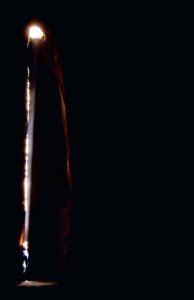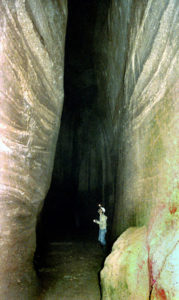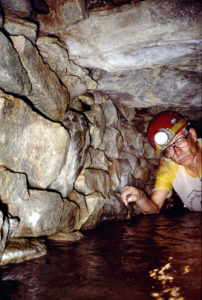Three thousand years ago engineers in Persia devised an ingenious solution to one of mankind’s most serious problems in areas without rivers and lakes: how to get water from point A, where it abounds, to point B, where it is desperately needed. Today their invention is generally referred to by its Arabic names, qanat or foggara, also known as galería filtrante in Spanish and filtration gallery in English. The qanat technology proved so successful that it quickly spread throughout the Middle East and to the far reaches of China. It preceded the aqueduct, it was copied and used by the ancient Romans, and the Spaniards carried it across the Atlantic to the new world, where numerous qanats are still functioning in Peru, and Chile. In fact, there are even Persian Qanats in Western Mexico.
Imagine the problem of transporting water long distances in ancient times. You might be able to dig a canal, but what if your water source is deep underground? You could dig a well to get at it, but you would require energy to lift the water high enough to flow into the aqueduct. Then you have the problem of pollutants falling into your canal and — in desert climates — you may lose a great deal of your precious water to evaporation.

Somehow, those engineers of 3,000 years ago came up with a solution resolving all of these problems. Imagine, for example, that someone had dug a hole up in the hills and found water at a depth of 20 meters and now the need is to carry that water to a flat valley three kilometers away. The qanat builders would trace a straight line on the surface from the “mother well” to the exact point where the water was needed. At regular intervals they would mark spots where narrow vertical shafts must be dug. When each shaft reached an exact, predetermined depth, a horizontal tunnel would be dug to connect the bottoms of all these shafts together. The tunnel would be barely big enough for a worker to stand in and it would slope downward at an angle of less than two degrees, meaning that water moving through it would flow at a very slow speed, causing little or no erosion.
The most difficult stage of qanat-building was the final connection of the tunnel to the water table at the mother well. This step was so dangerous that even today Iranians (who have some 274,000 kilometers of qanats in their country) still refer to these underground aquifers as “murderers.” Once water was flowing through the tunnel, each vertical shaft — with a diameter of about 70 centimeters — would be capped with a large flat stone to prevent evaporation and to keep the system clean. A properly made qanat would frequently have a lifespan of at least 200 years, usually providing centuries of life-giving water, easily offsetting the rather expensive initial investment.
All of this I learned only years after my first encounter with a qanat in rural Mexico. Here’s the story.
The Mysterious Hole
One fine day, I was standing inside a hardware store in the little town of La Venta del Astillero, located about ten kilometers west of Guadalajara in the Mexican state of Jalisco. I was mesmerized by the hundreds of items which were hanging from nails on the wall: everything from horse collars to hand-made, galvanized sprinkling cans. While I was absorbed in selecting pipe fittings and the like, my wife Susy stepped out into the street, looked up at the hillside north of the town and exclaimed, “John, I can see a big black hole up there… It looks just like a cave entrance.” Little did we suspect that what awaited us in those hills was an enigma that would take ten years for cave explorers, geologists, archeologists and historians to unravel.
The following day, we made our way up a gentle slope dotted with oaks and pine trees to the impressive, tunnel-like hole, seventeen meters high and five wide. To our surprise, the walls of this opening were not of rock but the hard-packed volcanic ash known as jal, from which the Mexican state of Jalisco gets its name.

We stepped into what seemed to be a large, single room in whose high ceiling we could see a perfectly round hole about two feet in diameter. Not far from it, we found another very similar hole. When we came upon a third such opening — perfectly aligned with the other two — we knew there was definitely something strange about what we were now calling La Cueva de La Venta. The room ended about 70 meters from the entrance in an enormous collapse of loose jal, far too crumbly to climb, through which daylight was streaming. Sticking out from under this huge dirt heap, which nearly reached the ceiling, was a pipe, from which water was trickling. Apparently the cave continued beyond the collapse.
Seventy-five Entrances
Upon the scene came Henri de St. Pierre, a French geologist with whom we had explored caves in Arabia and who had dropped in to visit us in Mexico. Naturally, the first place we wanted to show him was the big cave above La Venta.
After looking around inside the cave, we decided to climb to the mesa up above it. This was a wide, flat area planted with corn and other crops. Here we located the collapse, which, on the surface appeared to be a hole twelve meters around and filled almost to the top with loose jal. We started to investigate the mesa a bit more and, to our amazement, quickly found a string of small holes aligned with the collapse, and approximately 11 to 12 meters apart. We immediately began surveying and by the end of the day counted 75 holes forming a gigantic Y on the mesa.
Yech!
We plumbed one of the holes and found it was about 22 meters deep. A rappel seemed the only way to enter this part of the cave, but we wanted to have some idea of what we might encounter down below: an underground river? a sea of mud?
“This,” declared Henri, “we will clarify by casting down a probe.” We felt honored to participate in such a scientific approach to caving and put together the required materials: a length of one-inch pipe with a long piece of cord tied to one end. “Attention below!” shouted Henri as he dropped his missile down the shaft. It made neither a clatter nor a splash when it hit bottom, just a solid “thunk,” so we watched in silence as Henri drew the pipe back up to the surface. I had my camera ready to capture the historic moment. What would the core sample reveal?
Henri carefully examined the end of the pipe and suddenly twisted his nose in revulsion. “Merde!” he cried and suddenly there were no volunteers for rappelling.
One day we returned to the mesa and climbed down a cable ladder to the top of the great jal collapse. A small opening between the cave roof and the dirt pile revealed a long slope heading downward. Here was an easy way to check out the main portion of the cave and a convenient escape route in case we ran into anything disgusting. What we found was, once again, totally unexpected. We were in a long, narrow, fissure-like passageway whose floor was dry and which was anything but repulsive.
Golden Columns
In fact, the scene before our eyes was extraordinary. Through the curious holes in the high ceiling shone beams of golden sunshine which deposited bright circles of light on the dark floor. Suddenly, one of our friends on the surface disturbed one of the holes and particles of dust floated down the sunbeam, dancing like fairies and creating the illusion of a shimmering white column appearing out of nowhere in the darkness.
I simply couldn’t resist stepping into it and shouting, “Beam me up, Scotty!”
A cave with 74 evenly spaced roof entrances? We couldn’t explain it, but we considered ourselves lucky to have a big — and naturally lit —cave so close to Guadalajara and it soon became our favorite site for training novice cave explorers. The long, fissure-like passage was ideal for practicing “chimneying” and the evil-smelling part of the cave was very far from the entrance: a spot where the farmers above had decided to dump their garbage, locate their toilet and — believe it or not — pump up their drinking water.
Then one fine day we invited archeologists Phil Weigand and Chris Beekman to visit the place. Phil stepped into the big room and exclaimed, “John, this is not a cave at all. This is a manmade device for conducting water underground… Just look at the walls: can’t you see the hatchet marks? And your “skylights” — didn’t you notice the hand and footholds made by the people who once maintained this hydraulic system?” And that was the day I first learned about qanats.
Qanats Mexican Style
Chris Beekman eventually used air photos to prove that Qanat La Venta had at least eight kilometers of passages and, in 2004 and 2005, “mysterious collapses of the earth” near the town of Nextipac indicated that the network of tunnels is even more extensive than Beekman had estimated.
Our inquiries about the origins of this underground aqueduct eventually led us to a second qanat in Zapopan called “La Gotera.” Unlike the one in La Venta whose original floor was eroded dramatically over the years, La Gotera (the Dripper) is just high and wide enough for a short person to fit through and is in pristine condition, still producing a steady flow of water.
Exactly when these qanats were dug and by whom is an open question. A search of old documents in the Zapopan library revealed information on water projects carried out in Guadalajara in the 1730s by Spanish engineer Padre Pedro Buzeta, but nothing on any projects outside of the city. However, Weigand has found evidence that a Spanish engineer built at least one qanat in Tlaquepaque, suggesting that the same person — probably Father Buzeta — was also responsible for the qanats near La Venta.

Apart from these, we knew of no other qanats in Jalisco until a year ago, when we walked into the plaza of Amatitán, located 35 kilometers northwest of Guadalajara, and found water pouring out of a man-made tunnel in the side of a high hill. With permission of the local authorities, we followed this tunnel to its end, 113 meters away and saw that it was indeed a qanat, but adapted to the particular circumstances of Amatitán. Instead of digging vertically into the hill, workers had tunneled into it horizontally, heading in various directions until they hit water. A few months later we found a second, similarly designed qanat near Amatitán, at a place called Chimulco. These two qanats, apparently dug sometime in the 1800s, still produce steady flows of water today, not only for the people of Amatitán, but also for the nearby Herradura tequila distillery.
Very recently, we received a call from a resident at the west end of La Venta. “A hole suddenly appeared on my land,” he told me, “and my tractor fell right into it. I heard you might have some idea what caused this.”
After looking inside this four-meter-deep hole, I asked the owner if he knew of any other strange holes or tunnels nearby and — sure enough — I was soon staring down a narrow shaft about ten meters deep, located right on the side of the Guadalajara-Nogales highway. This hole lay due south of the collapse, and I could see we had discovered another North-South-running qanat near La Venta. This is the fifth qanat we have studied in Jalisco and I suspect it won’t be the last.
Without a doubt, however, the most successful qanat we’ve seen in Mexico is one we were not allowed to enter….
Good for 400 years
We were in the state of Zacatecas where we had come to explore a cave which — like the nearby, world-famous caves of Naica — had no natural entrance but had been broken into by miners. Here we discovered several rooms whose walls, ceiling and floor were completely covered with shimmering white crystals. While photographing these marvels, we happened to mention Qanat La Venta to our geologist friend Nick. “You won’t believe it,” he said, but there’s a tunnel like that, with evenly spaced vents, delivering water to a little town not terribly far from here.”
So it was that the following day found us driving along a spectacularly dusty road through the wid flat Zacatecan desert into the little town of Cedros, population 624, located in Mazapil, “one of the poorest and most marginalized municipalities in the country” (MiMundo.org).
Nick led us to a small steam running through the town. We followed it upriver to its source, a dark tunnel disappearing into the hillside. At its entrance, we found a locked gate made of strong iron bars, but we could see that the tunnel had the typical measurements of a qanat and, further up the hillside, we immediately came upon the evenly spaced shafts we expected to see — but in this case, a neat, clean brick structure had been built over each opening. It appeared obvious that this qanat was meticulously maintained and of great importance to the people of Cedros and, in fact, when we questioned several old timers, they pointed out that this little stream had been the only source of water for the whole town for most of its history. Nevertheless, not one of our informants had any idea how old their galería filtrante was, nor who had built it. Eventually, we discovered that Cedros had been founded ‘way back in 1568 and it seems quite likely that that is also the year the filtration gallery was dug. So, until very recently, when the technology for drilling deep wells arrived, the Qanat of Cedros had been operating continuously as the community’s only source of water for around 440 years. Maybe they should put up a plaque to honor those Persian engineers who solved this Mexican town’s number one problem three millennia ago.
















Live these stories
fascinating!